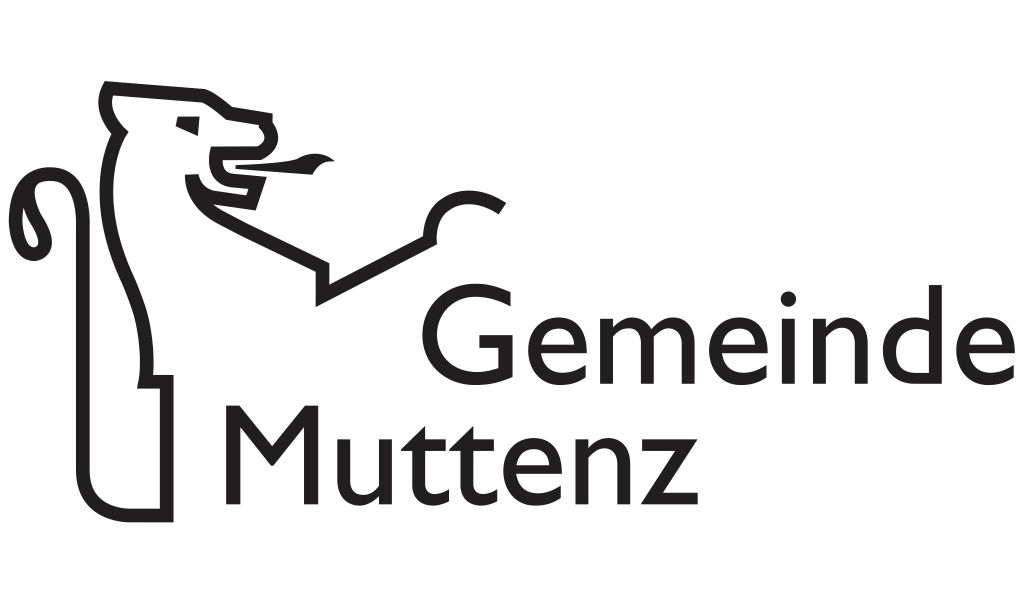Regionale 20
Step out!
24.11.2019 —
6.1.2020
This year marks the 20th anniversary of the Regionale exhibition format, which currently comprises 19 institutions of the Dreiländereck, presents around 150-180 artists of the region each year and includes the Kunsthaus Baselland as one of its five founding institutions.
Under the title Step out! Kunsthaus Baselland presents 14 artists employing sculptural positing to act from (two-dimensional) area into (three-dimensional) space. Physically stretching out into space also means for a number of the artists to mentally set themselves up in it, to create models that can point to something external, yet also invite a counterpart to join in on this mental journey. The exhibiting artists, almost all of them with an entire or large segment of a room to themselves, invite the visitors on a course through the Kunsthaus; to an encounter with in part new works that they developed based on the architecture of the Kunsthaus (e.g., Katrin Hotz, Simone Holliger, Maude Léonard-Contant, or Sanna Reitz, who was invited by the Regionale to develop a project for the anniversary that can be experienced at the exteriors of the Kunsthaus). Also shown are works whose ideas already existed, but that are now being expanded on (as for Gin Bahc, Jorinde Fischer, Franziska Furter or Jürg Stäuble). In this context, we were able to realize the large-format, multi-part, and as of yet unimplemented work from the 1990s by Reinach-based artist Dadi Wirz. The works of Urs Cavelti, Kaspar Ludwig, Laura Mietrup, Kilian Rüthemann and Julia Steiner as well have yet only occasionally or never been seen in Basel. This once again shows the great quality of the Regionale: discovering well-known artists through new works or getting to know artists who shape the artistic landscape of the tripoint region.
Beyond that we would like to take the moving part of the Regionale literally and invite you to join us — in addition to the bus tours offered by the Regionale — on three dates to embark for Liestal, Freiburg i. Br. and Mulhouse to visit the local exhibitions and to discuss them with the curators. We‘re celebrating 20 years of Regionale with (new) artistic productions, discoveries, conversations and encounters in the region.
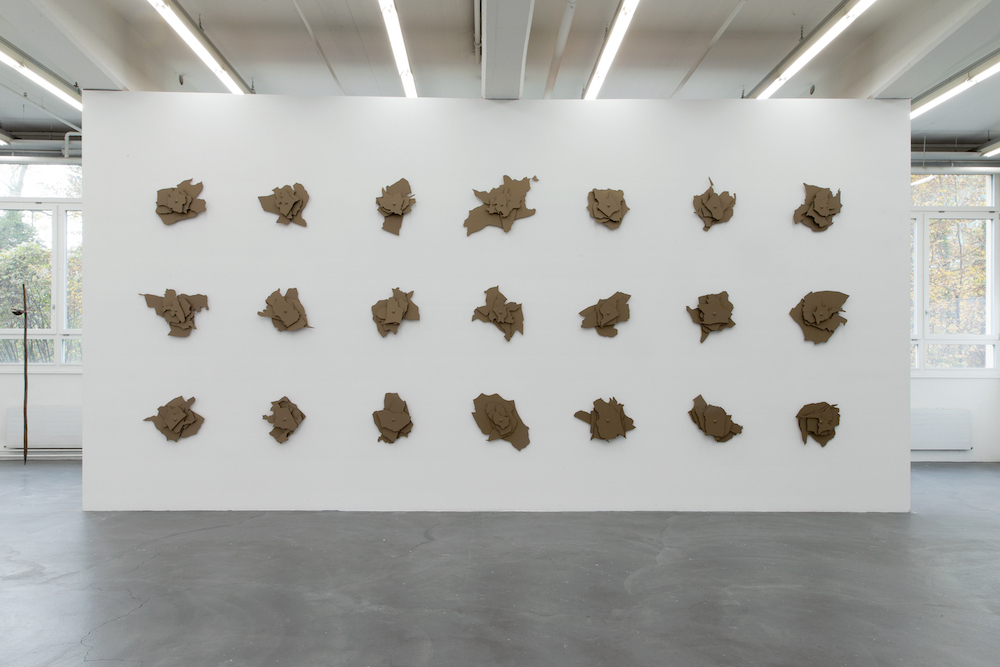
After almost 30 years, one of Dadi Wirz's largest works is being realized — the Wandskulptur Baselbieter Gemeinden. Wirz had once entered it as an art-in-architecture project for the municipality of Pratteln — but it was not implemented. At the time, the artist's model depicted only three municipalities of the canton of Basel-Landschaft in their geographical outlines on a 5-millimeter-thin brass plate. In 1990, there were 84 Baselbiet municipalities intended in the artist's concept. Today, there are 86, now united on the 8 x 5 meter wall in the Kunsthaus. The silhouettes of the municipalities are understood as sculpture, strung on short axes so that they all are rotatable and remain individually mobile. In this way, they can be moved carefully by the spectators. This creates a constantly changing overall picture of the sculpture, functioning both as an abstract posit as well as a specific representation of the Basel-Landschaft municipalities. Yet the wall sculpture by Dadi Wirz is not a representation of a geographical situation alone, it is light despite its weight, it is humorous and speaks of a longing of the artist for a connection and fluid togetherness, one that is able to overcome boundaries as well. (IG)
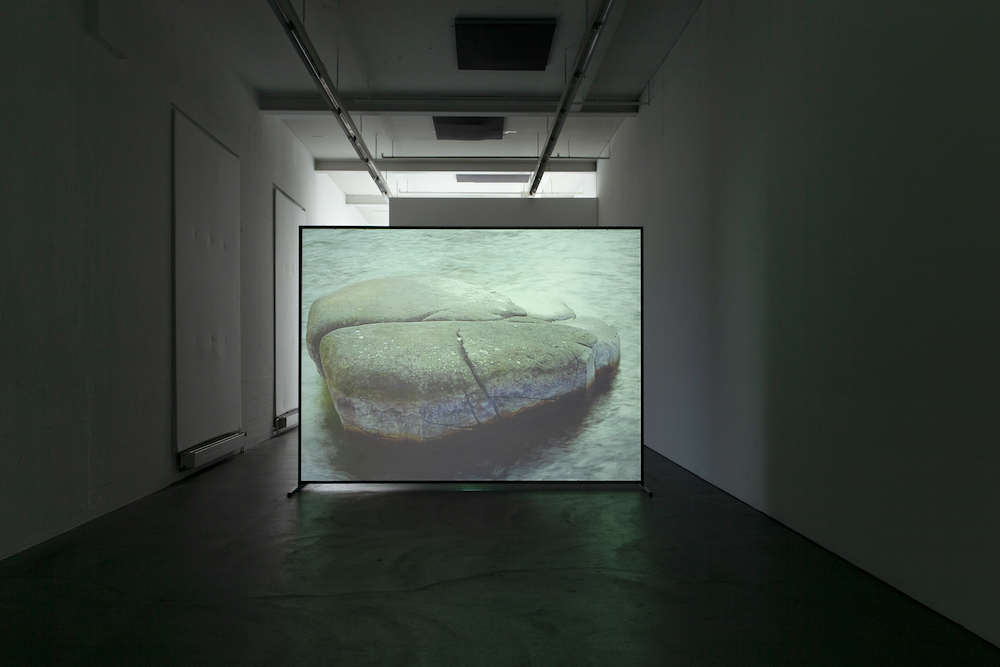
For Kilian Rüthemann, the concept of sculpture or sculptural position is an open one. Despite him coming from a classical stone sculptor training and well knowing how to handle materials such as stone or marble, sculpture is more than that to him. Getting to the bottom of different states of materials, their presence in space, their incontestability or proportionality, are topics of sustained interest to the artist. In the center of the room at Kunsthaus Baselland, Rüthemann now presents a steel structure, on it a back wall projection of a stone surrounded by water. From time to time and hardly discernible, sea lions, that seem to be diving around the stone, appear. So, an artificial stone, shaped by the gentle swell the animals create, located in an artificial environment like a zoo facility? The artist does not offer a definitive resolution. Instead, the image is interrupted by short video sequences at irregular intervals, almost imperceptibly. Shown here are countless excited hands, — as part of the ritualistic circumnavigation of the greatest Muslim pilgrimage — touching and thus over time deforming the exposed stone corner of the Kaaba, the largest Islamic sanctuary. Rüthemann pieces these two sequences together with skill, without comment and at the same time charging each other:
An originally mundane stone — the corner of the Kaaba in the sequence is not the one with the black, semiprecious stone but the opposite corner — becomes something sacred through ritual action; in the other sequence, sea lions circling, but not touching or climbing an artificial stone. Last but not least, there is an association with artistic, sculptural action in general in its ability to transform materials into new shapes by way of manual interaction, editing and touching. (IG)
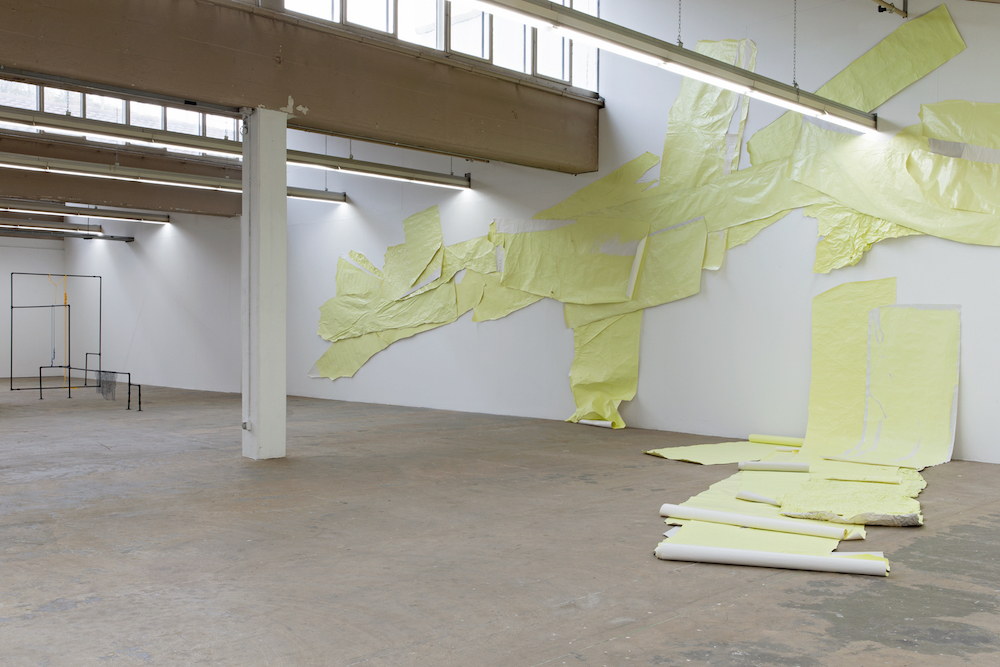
The Biel/Bienne artist Katrin Hotz connects site-specific painting and architecture in a playful way. She starts out with the material paper, which she then develops in installations that become object-like and spatial. In the work group enough — an expansion of the tache series — paper panels are painted, torn, crinkled, folded and glued together. This technique creates new connections, material losses and in some places, partial compaction and overlap. The artist has been working with this artistic method for several years. Due to this process, her works are always new and dependent on the space and its conditions; whether the paper breaks or furrows can never be planned precisely, but develops at the moment of formation.
Katrin Hotz's work always decidedly engages with the architecture of a space. Thus, a unique surface emerged at the Kunsthaus, one that connects to its walls or overwrites their corners. The elegant transitions create new dynamics in the room. Here, the artist works with a high-pigmented, matte and shiny brimstone butterfly/sulfur yellow. With her artistic strategy, Katrin Hotz operates between site-specific painting, relief-like installation and the lightness of drawing in space. (YE)
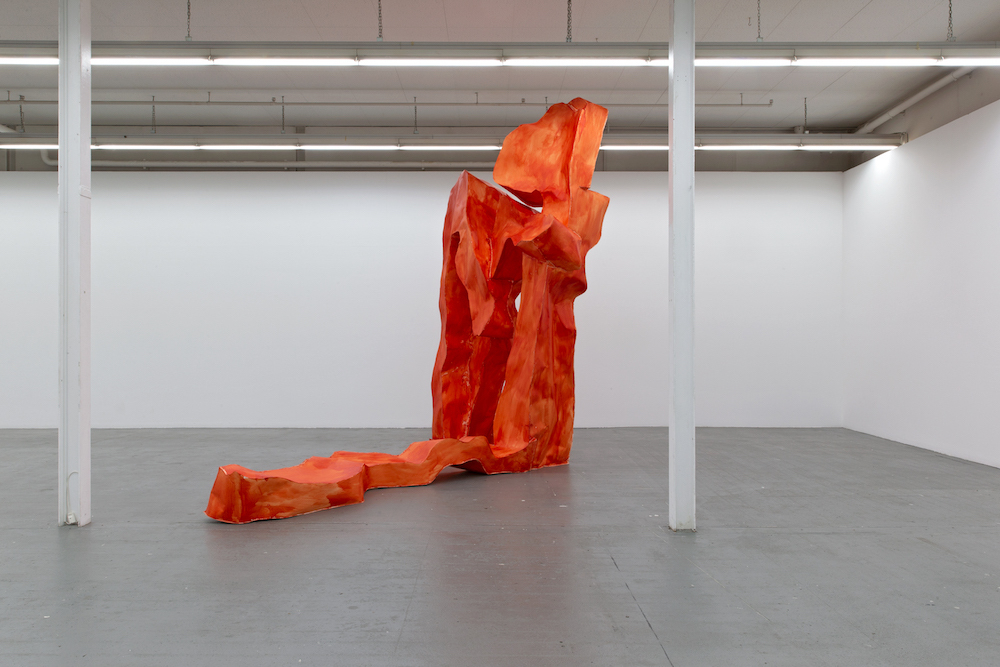
The sculpture is freestanding in the room, irrefutable, persistent — it seems to flatter its surrounding architecture a bit. A leaning and reclining, an extending and stooping become almost discernible. It appears to be light, even a little tender because of its light color, like a model that already speaks of big things, but one that may allude to even bigger things.
Simone Holliger, of Aargau origin, who lived in Geneva for a long time and has now moved into her new, permanent residence in Basel, activates the space with her sculptural contributions. Far be it from her to seek to occupy. Holliger doesn't bring her sculpture, unloads it and sets it up. Like a malleable shape that is built up slowly, it grows on site, seeks its ideal location as well as its own equilibrium throughout its formation. The material, as steady, elegant and permanent as it seems, it is as fragile and temporary: Simone Holliger works with paper and glued edges. From it, she creates works that are freestanding or can be installed on a wall. Their shapes supporting and strengthening the material, holding the horizontal and the vertical, rebelling against gravity, standing on legs, carried by arms, and, above all, are a balanced act, keeping artistic idea as well as possibilities and limitations of the material in equilibrium.
Holliger's works clearly take a step away from sculpture as a monumental assertion and final position in space, towards an offer like the presence of a human being in space, like a sound or thought that carries on after the exhibition, capable of transforming into new shapes. (IG)
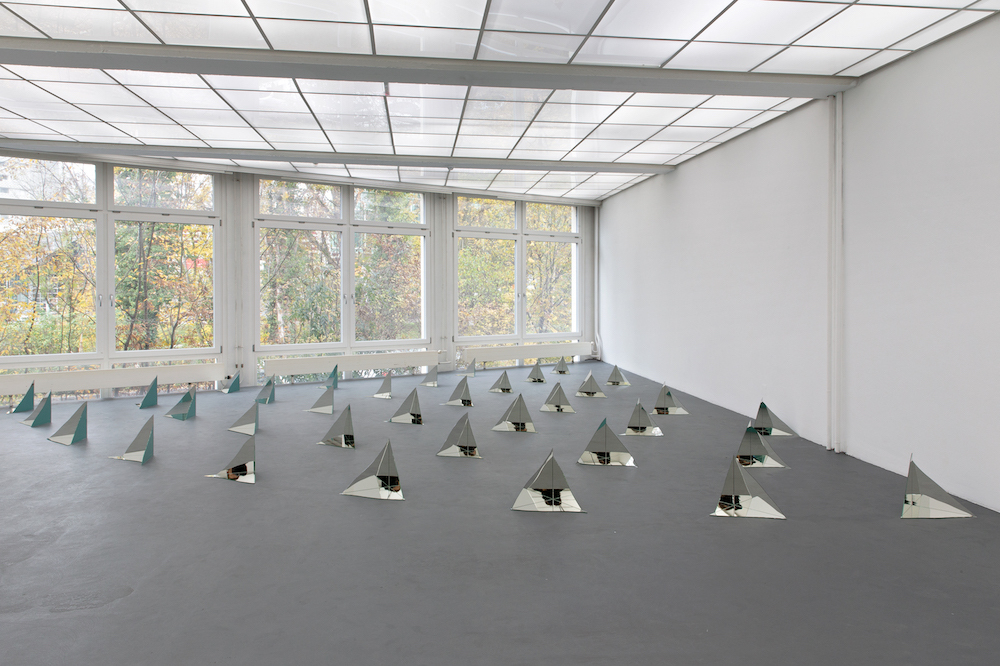
Who doesn't know them in today's day and age, these various aids to capture or reflect one's self. Upon entering the gallery space with the large window front at the Kunsthaus Baselland, the gaze immediately turns towards the floor in order to remain on the reflection of one's own self as well. Jürg Stäuble presents several triangular bodies made from mirror shards on the dark floor of Kunsthaus Baselland. The small, pyramid-like objects are in turn composed of three smaller mirror triangles that protrude into the room with their sharp points.
Although conceived as early as 1979, the piece is gaining in topicality — given the narcissistic traits characterizing today's society — which is why the artist presents it periodically and in different ways and places. Taking a closer look at the small objects, their front side forming a corner that shows the observer upside down becomes noticeable. Their own movements in the room are mirrored in all these corners at the same time. They are virtually followed around by themselves: The astounding part is, according to Stäuble, the visitors are always focused on themselves when they pass by, that is they stand in the crosshairs of the mirrored corners and don't see the other persons who may be in the room as well. (PH)
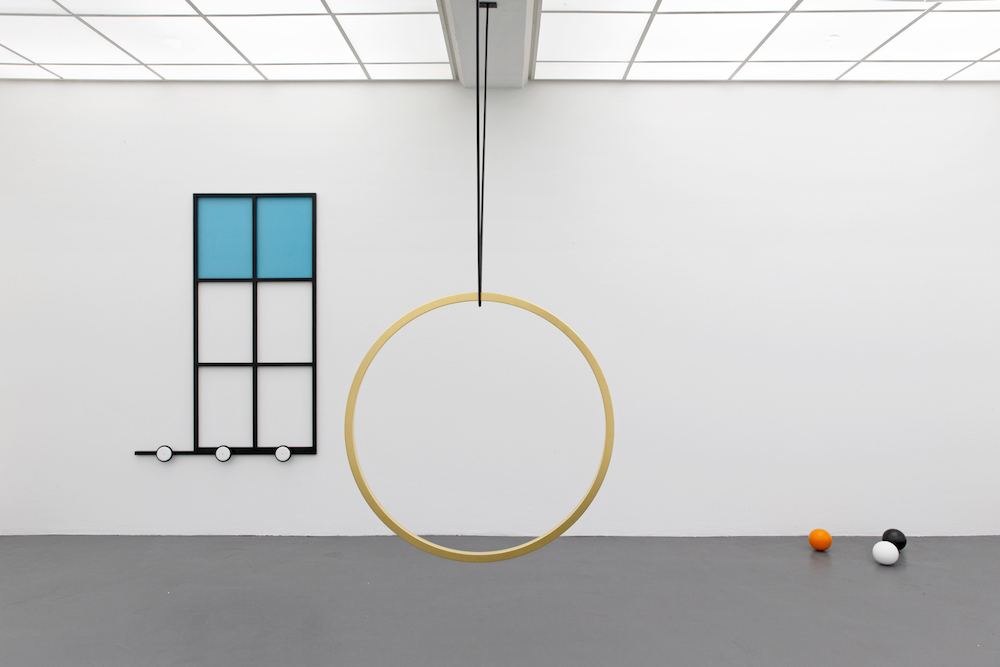
The objects of Laura Mietrup — whether freestanding or installed on walls —always have an inherent simultaneous mystery and fascination to them. Most of the time, they remind of something familiar, something previously mundane, yet also withdraw from such interpretations immediately. Moreover, the precisely executed objects reflect the great craftsmanship and the artistic strategy of the artist in their shape and surface: Mietrup combines various materials such as wood, acrylic glass, plastic and chrome steel with an incredible homogeneity of formal language and a uniformity of artistic narrative at once. From her artistic experiments with shapes and lines emerges a kind of alphabet that appears both abstract and narrative. This language, however, is fictitious and – albeit unreadable — a form of communication arises. In the connection of objects and their color, arrangement and presence in space, the symbol-like works can be understood. Together, the pieces interact lightly, elegantly, humorously.
The work o. T. (Fenster auf Rädern) for example, creates a connection between the outside and the inside by referencing the real architectural conditions — a script that, despite its high degree of abstraction, becomes legible. In her works, Laura Mietrup skillfully unites the unambiguous with the enigmatic and playful, the light with the profound, and creates a new symbolism worth decrypting. (YE)
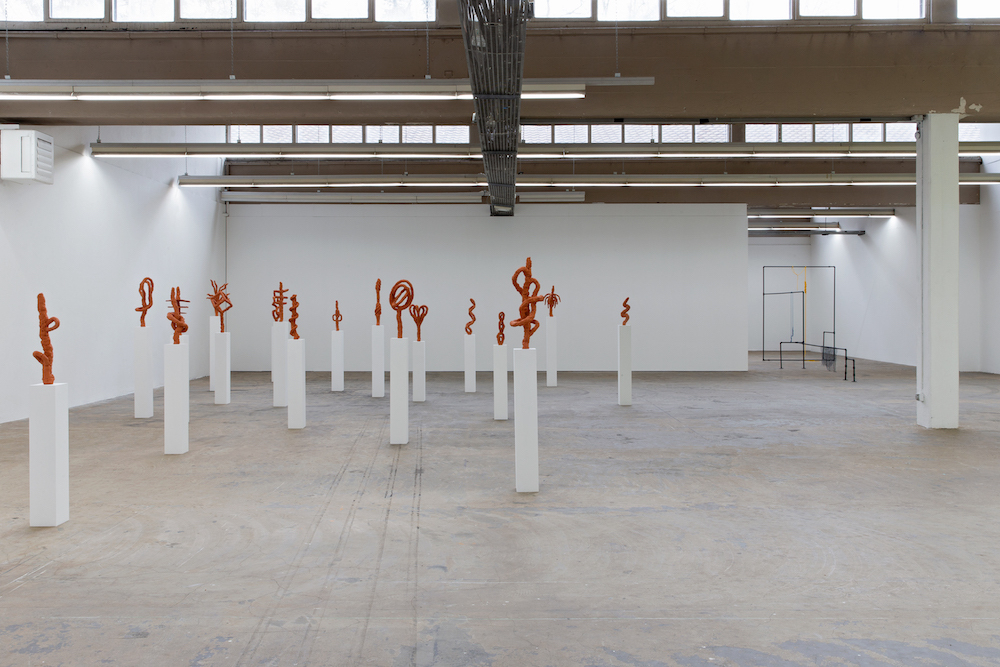
The 20 reddish-brown fired clay figures by Selina Baumann on the ground floor of the Kunsthaus, which are classically presented on pedestals, are quickly recognized to form a whole, a group the artist plainly titled Skulptur 1-20. All surfaces of the different sculptures are uneven, rough and convey a great spontaneity and directness at the moment of realization. Where they are significantly different, however, is their respective shape. Each is a unique piece that has been shaped at a fast pace into spirals, floral elements or organic structures — some symmetrical, others uneven.
The second multi-part sculpture of the artist is comprised of plant pots stacked in differing amounts. High and low towers result in a Field of Stelae that doesn't seem finished. The stacking could be continued, increased, or decreased. The Hain, the title says, is a small and open forest. Yet the bluish verticals are more reminiscent of trunks of exotic palm trees without foliage. Both their serial and fast-paced production as well as the numerous repetitions of an everyday object rethink an established vocabulary of forms and follow a conceptual approach. Key for both of the bodies of work shown at Kunsthaus Baselland is their concept of a series, without losing individual characteristics or neglecting a counterpart in the process. Baumann always conceives her series as an invitation to cautiously tread through them, taking measure for one's own presence in the space. (IT)
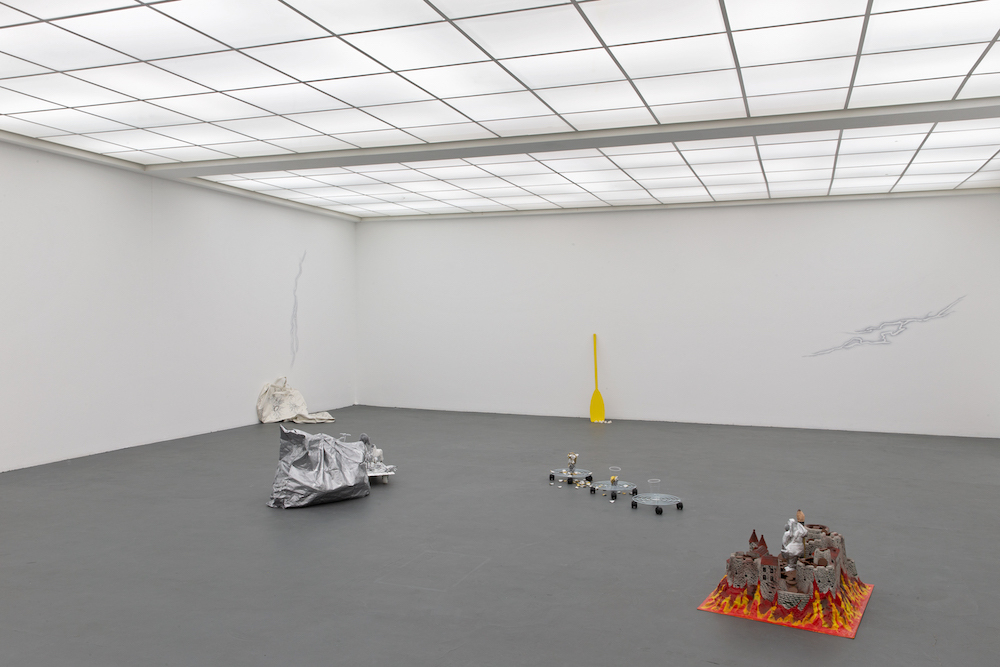
Social issues are at the basis of artist Gin Bahc's work. She is particularly interested in social psychology: What do people think and experience, how do they behave in their social environment? In the beginning, there's the drawing. Bahc starts out with drawings usually drawn on walls directly, then she continues into space from there. The results are large-format wall works and expansive installations. At Kunsthaus Baselland, the artist shows one of just these: various objects such as luggage items combined with wall drawings. The shape and type of luggage alone often says a lot about their carrier or owner. Almost all of Gin Bahc's objects refer to moments of locomotion, transit, and transport, interconnected via aesthetic choices of the artist. Their combination and compression not only makes the objects lose their purpose, but also allows to rethink their associations and attributions. All objects are directed at locomotion despite them remaining static themselves. Thus, the room also reminds of a suddenly abandoned place of transit, a train station or airport area for instance. Everything seems ready for departure. We're in a situation of constant movement that amounts to a standstill. In this way, it's especially topics like flood of imagery, media presence, simultaneity, superimposition, ambiguity and fast pace as typical side effects of modern society that the artist discusses in her works. For her, according to Bahc, making art means an engagement with different life situations, the experiences of our time shaped by media, the increasing medialization of one's own life. (PH)
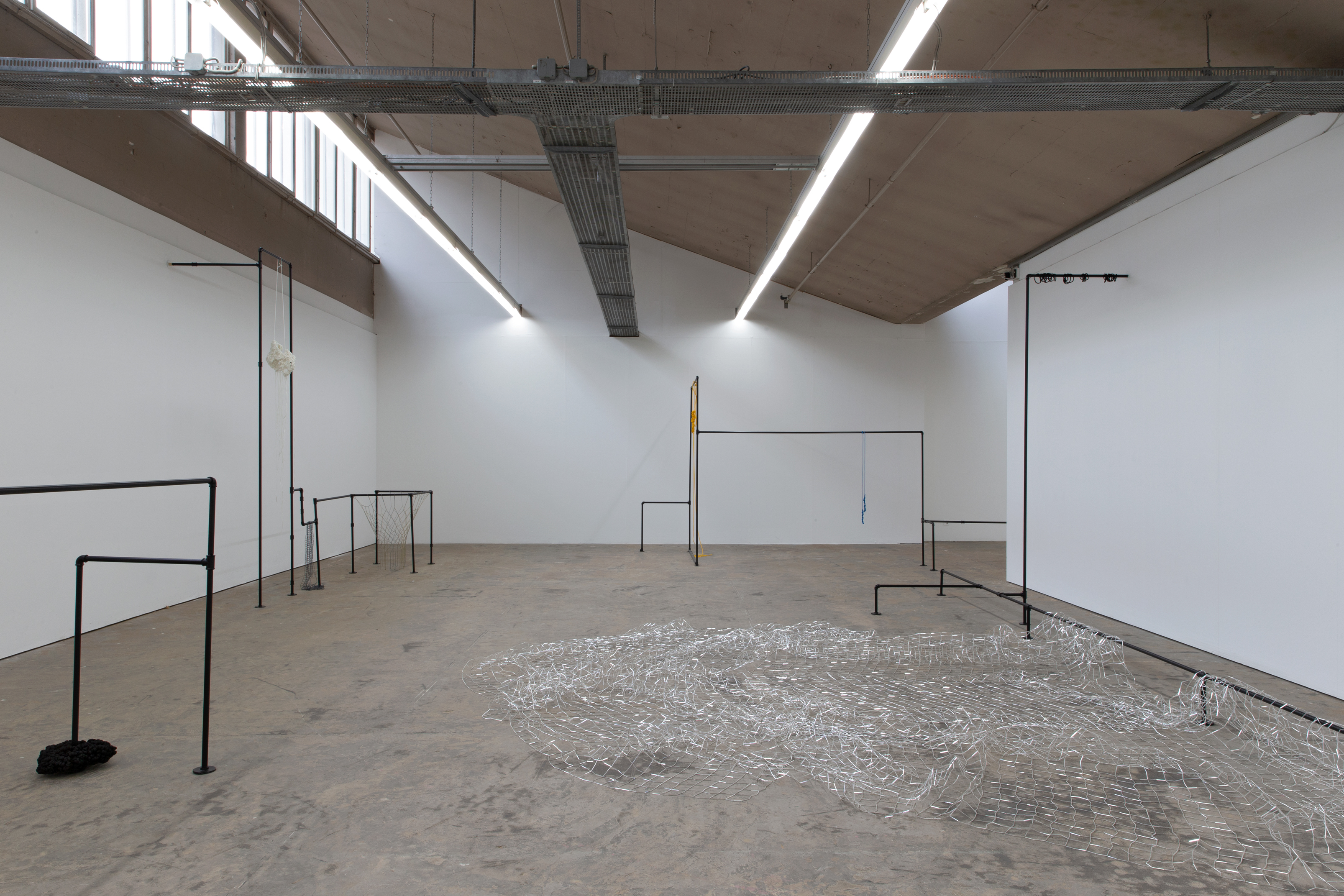
Black steel pipes branch through the negative space of the Shedhalle, reminiscent of the irregular lines and strokes of a three-dimensional drawing. The work of Franziska Furter spans the entire room. The pipes are supported on the ground and partially disappear in walls or seemingly end in a void. Lattices of strings and nets of beads on nylon threads hang from individual pipe elements, following the law of gravity. Knotted ropes interfere with the straightness of the framework and dissolve into individual soft lines on the ground. The rods' rigid horizontal and vertical lines – interrupted by the light, partially net-like objects – channel the bodies of the visitors in the space. One stands, walks, bends, and in the attentive walking around the installation, the positive/negative, the formulated/open become tangible – the empty spaces become experienceable.
The title is a quote from the novel The Waves by British author Virginia Woolf. A surreal, dreamlike space nestles around the viewers like a broken wave around its shore. The viewer must and may search their path alone/individually. (IT)
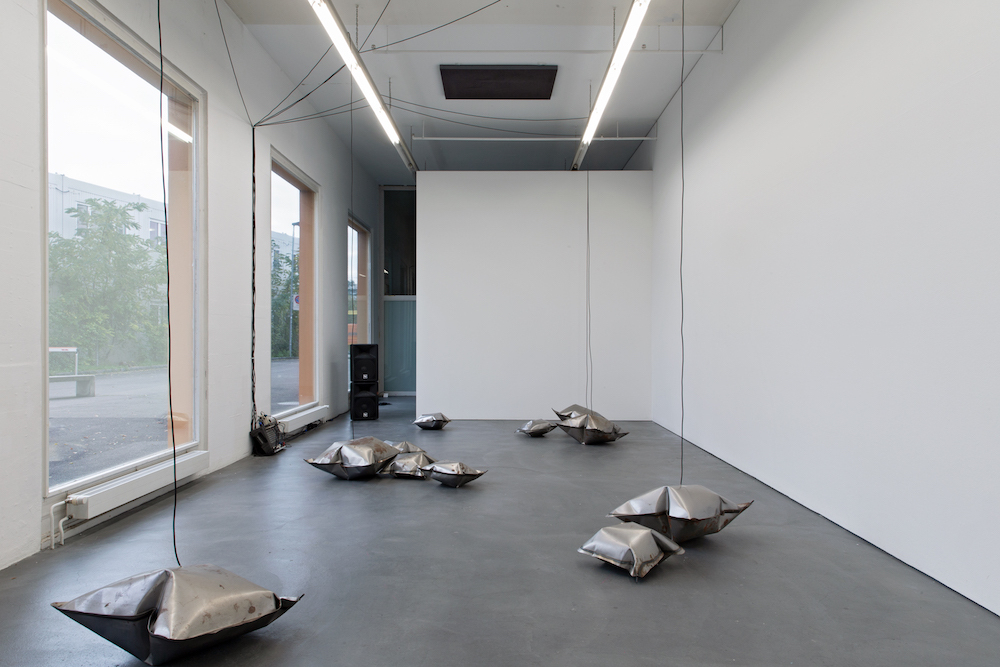
Diffuse sounds lure the visitors into the back room of the long annex of the Kunsthaus. The sound leads the listener right into the center of an installation of inflated steel pillows that are arranged on the floor and connected to a mixing desk by meter-long cables routed through the room.
With his work, why should I buy pillows if all I want is sleep, Kaspar Ludwig creates a space that encourages reflexion and exploration. The artist uses storytelling, places partly everyday objects in a surreal context or combines opposites in a humorous way. Part of his artistic strategy is to explore a material and its character in order to develop his works from it. For a long time, Kaspar Ludwig lived in Carrara (IT) — an (art-)historically charged place — and describes this retrospectively as an important source of inspiration. The basis for the piece shown at the Kunsthaus are steel pillows, which are used in Carrara as technical devices to blast off rock in marble quarries. Due to their brunt, such pillows can move up to 70 tons of stone. And thus these objects embody an incredible power for Ludwig. In his installation, however, the artist staged them with a great lightness. Originating from these pillows, deep bass sounds are created. They're generated by the movements and vibrations of the visitors in the room, allowing them to also physically experience the work. (YE)
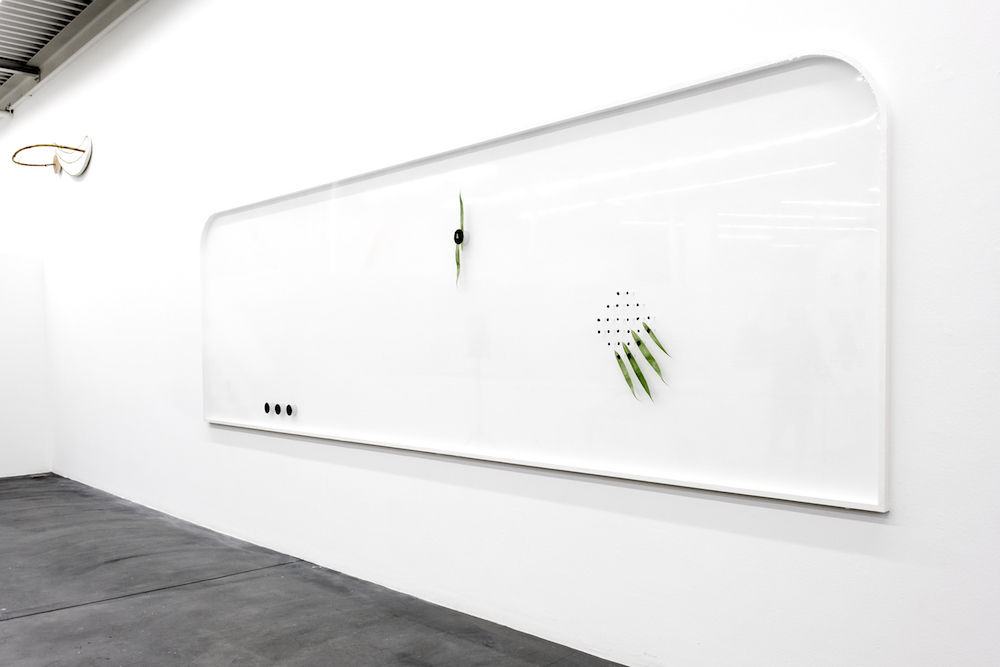
The installations of artist Maude Léonard-Contant exude a subtle tension that is less accessible to description than it is to experience — a script that may seem fine-grained, poetic and at first puzzling. The result is a system of signs that can be decrypted in layers and through an understanding of interrelationships. Léonard-Contant creates delicate sculptures using materials such as clay — a material that takes time and rest to develop; next to it are wall objects whose top layer have a tensioned plastic skin. The artist accompanies these with bamboo-plaster-objects that seem to grow out of walls or floors like dainty antennae. For Léonard-Contant, plastic, plaster, and bamboo represent materials whose requirements only develop through time-consuming growth and natural processes. The artist is particularly interested in these references, the layers and relationships that the works create among themselves and that allow us to enter a dialogue with them. This language does not reveal itself through something clearly defined, but through a quiet, a loud, a sound, a rhythm, in order to simultaneously proclaim about complex correlations of the today and the now. (IG)
Rushing through the rooms of the Kunsthaus Baselland, the flying birds of Basel artist Julia Steiner will catch one's eye — irritating and fascinating at the once. The massive birds of prey cast in bronze seem to wind around poles, in search of the big prey. The cast beanpoles, fashioned from the same material, hang just above the ground and are not only connected to falcon and sparrowhawk, but support them in their movement, while hanging from the ceiling themselves like a slightly off-balance plumb.
The birds were produced using the technique of lost mold casting, where the bird's molds are fully burned away and thus can only be poured once. The result is a surprise even for the artist and ultimately beyond her influence. Sometimes, the delicate feather stripes turn out in fine detail, others, the birds sustain larger defects on their bodies. The objects appear light and airy and yet heavy and ephemeral. And at the same time, like coordinates, they measure the space they are installed in. Steiner's birds set out and move around in space, up until the end of the exhibition at the Kunsthaus, when they move on towards their next big exhibition. (PH)
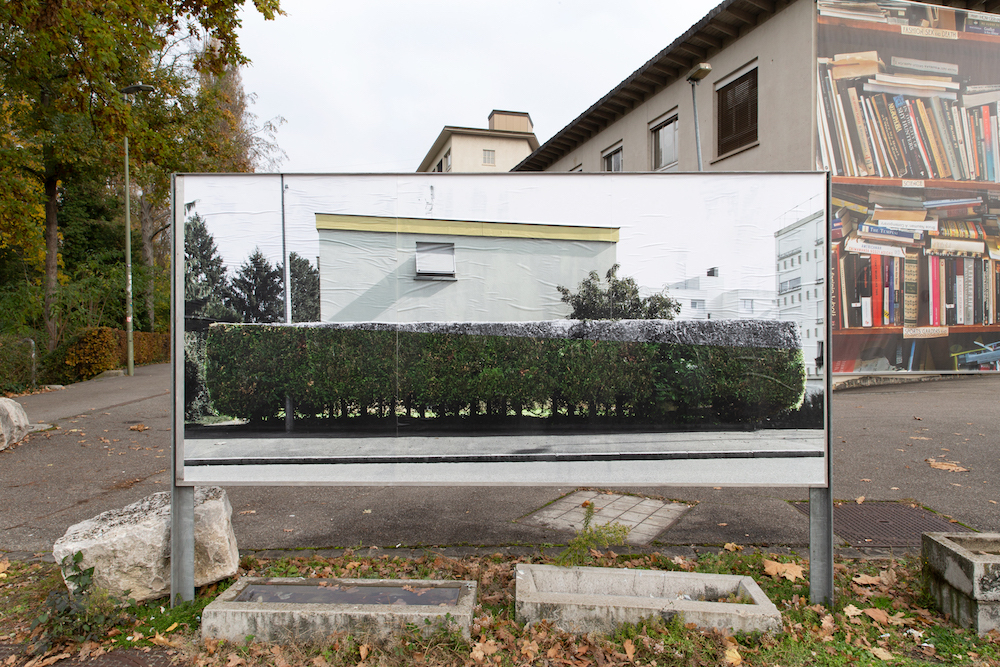
In order to properly celebrate the 20th anniversary of the Regionale — in addition to the annual open call — a call for submissions for new artistic productions was launched. The projects by Simone Etter & Marianne Papst (artist collective marsie) and Sanna Reitz, both of them located in public space, were selected for realization.
With TOPI (Social Sculpture Suburbia), Sanna Reitz fills large-format wall surfaces in Basel, Freiburg, Mulhouse and Strasbourg. Her photographs show and examine geometrically trimmed hedges that mark property lines on the German, Swiss and French sides of the suburban tri-border region. The artist digitally edits these to intensify their formal architecture, sculptural quality and clear structure. She is interested in the artistic quality of these temporary, site-specific interventions the loving and diligent hobby gardeners have created here. Yet in actuality, the hedges' purpose is to keep the neighbors at a distance and delimiting what is theirs. At the same time, TOPI connects the cross-border and tri-national claims of the Regionale with the "Abstandsgrün" (distance-green) that prevails the suburbs, by transplanting it into the urban centers of the respective neighboring countries.
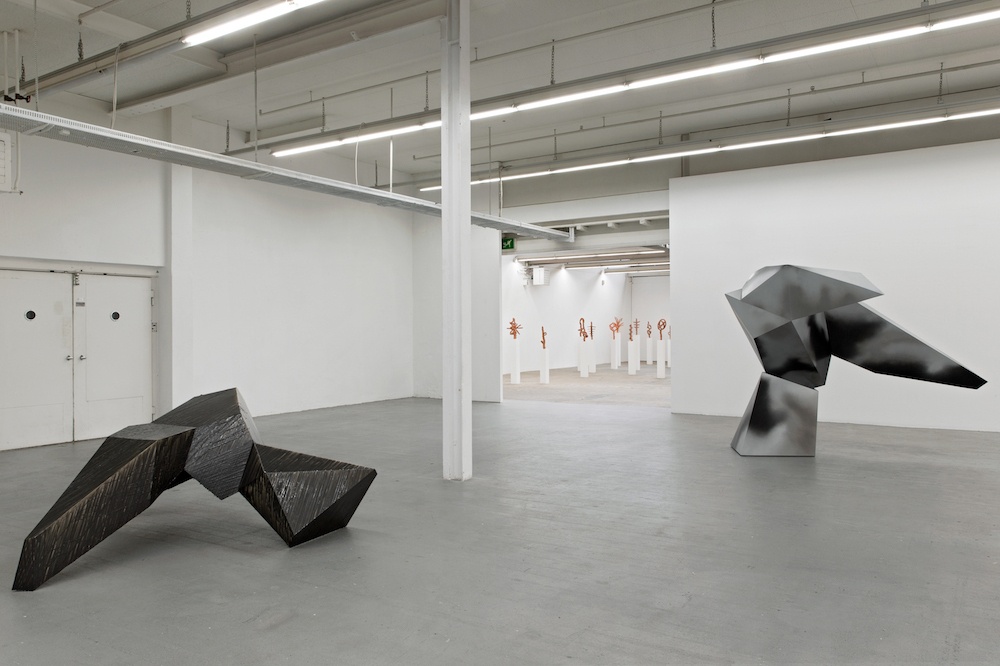
Reflecting, black epoxy resin coats the geometric bodies in flowing lines and forms a dark sculpture. It is a part of a group of three near identical crystalline shapes that the artist Urs Cavelti tilts, lays and erects in the middle of the basement room of Kunsthaus Baselland. In their arrangement, one bright and one gray, spray-painted shape face each other — in dialogue with one another —, while the black sculpture was placed with some distance. Despite their very similar base shapes, the different placements and surfaces create different readings. A feeling of lightness is opposite one of heaviness. The shapes not only seek their own stability, but also the equilibrium of the entire group in the room.
Upon learning the title of the installation, werden sein vergehen, a narrative chain of the sequence of verbs emerges. According to the artist, they describe a temporality, similar to the sequences "rise, walk, fall" or "birth, life, death". At the same time, the colors of the individual sculptures point to a succession. This illustrated time can be understood as an invitation to circle around the group of sculptures and to experience it from different points of view. Regardless whether viewers now read a temporal succession of different states in the group or do rather prefer a purely abstract and formal interpretation — in both cases, our own bodies serve as the point of reference that we are present in time with. (IT)
Right at the beginning of the exhibition, the expansive two-piece work by Jorinde Fischer draws the visitors into the interior of the Kunsthaus. The artist seduces with her almost perspective conceptualization of this piece to perceive the room in its entire depth. Textile, steel and architecture form the basis of her installations, which are staged individually the respective spaces. She playfully engages with the architectural surroundings, the present materials, the materials she uses — soft, sensual fabric to hard, industrial steel — as well as with the given color schemes. On a long steel beam at a height of about four meters, the artist attached a delicately colored, elastic fabric panel and — by fixing it to a steel plate on the floor — lets it formulate a V-shaped negative space. The artist reacts visually to the architecture of the Kunsthaus Baselland with an escape towards the upper gallery.
Despite the stretching of the fabric, the elastic material causes a slight rotation and thus great dynamics and tensions throughout the entire room. The delicate color of the stretched and pleated cloth makes the work seem almost painterly – akin to a brushstroke in the middle of the room. Clear, with few placements and at the same time with high poetry, Fischer reacts to space and place. (YE)
Selected press coverage
Basellandschaftliche Zeitung, 21.11.2019
Radio X, 10.12.2019
SRF2. Blick in die Feuilletons, 10.12.2019
Basler Zeitung, 3.1.2020


